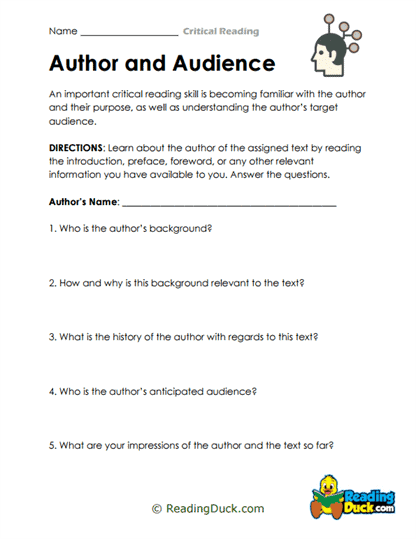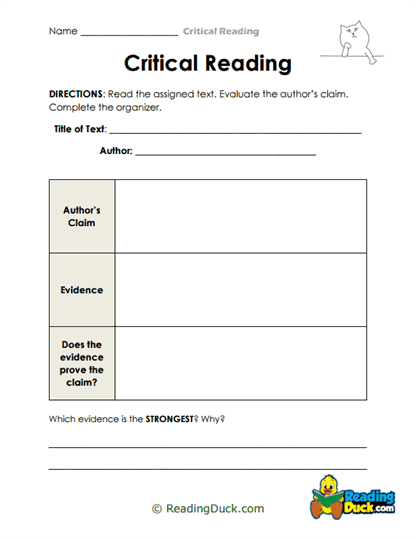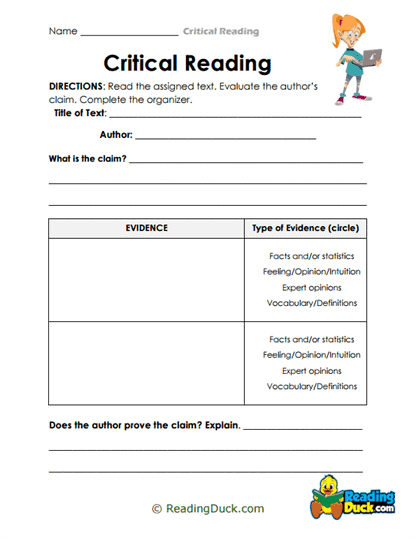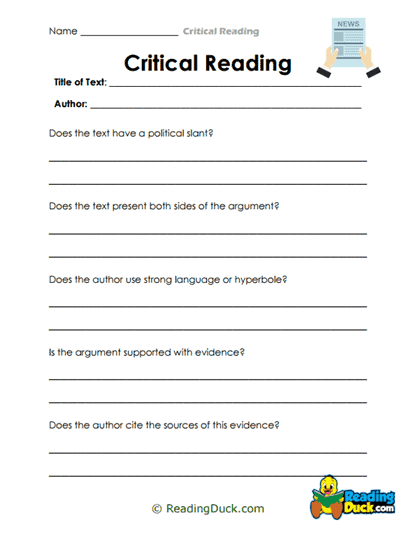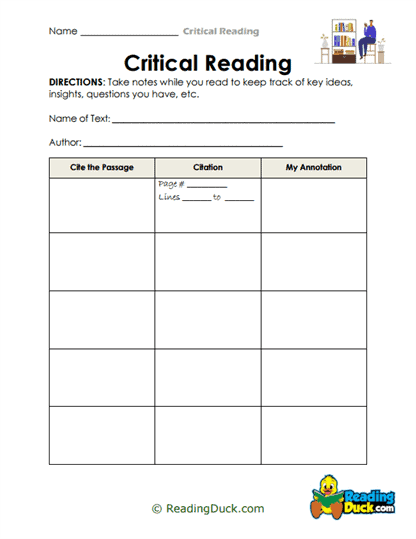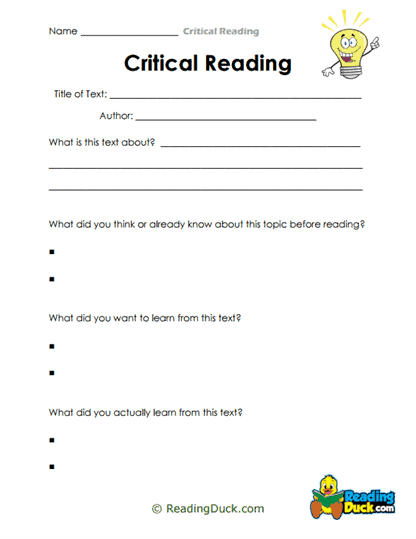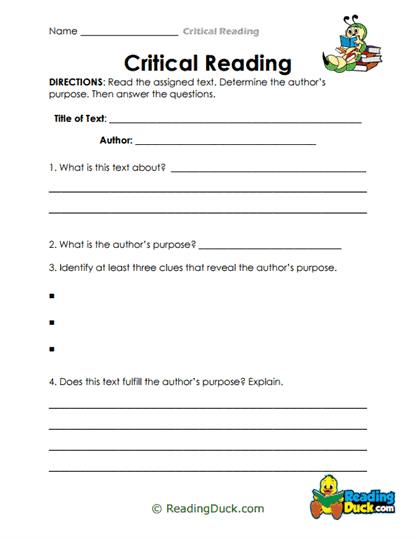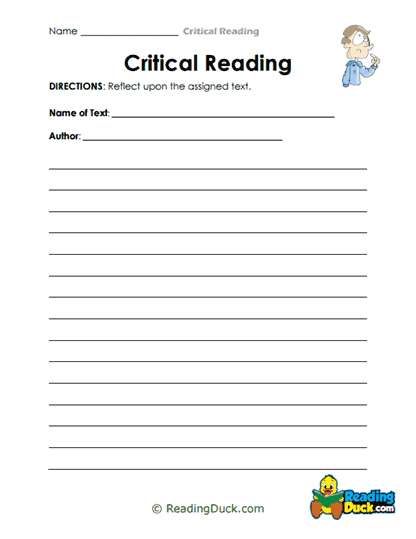Critical Reading Worksheets
About Our Critical Reading Worksheets
Our collection of Critical Reading Worksheets is meticulously designed to support early reading development, falling under the 'Phonics' category within the 'Pre-Reading' section. These worksheets serve as an essential tool for educators and parents alike, providing young learners with the foundational skills needed to become proficient readers. Available in convenient PDF format, these worksheets are easy to view, download, and print, allowing for seamless integration into both classroom and homeschool settings. To further assist educators, each worksheet comes with a downloadable answer key, ensuring that the learning process is both effective and efficient.
Understanding Critical Reading in Early Literacy Development
Critical Reading is a fundamental skill in early literacy development, crucial for fostering a strong foundation in reading comprehension and overall literacy. As a professional licensed teacher specializing in pre-reading skills, it is essential to recognize the value of teaching Critical Reading from the earliest stages of a child's educational journey.
What is Critical Reading?
Critical Reading involves the ability to read text with an analytical mindset, assessing and evaluating the content rather than simply absorbing it. For young learners, this means not only decoding words but also understanding the meaning behind them, asking questions, and making connections with prior knowledge. This skill goes beyond phonics and word recognition; it delves into comprehension, reasoning, and the ability to think critically about what is being read.
Importance of Critical Reading in Early Literacy:
- Foundation for Comprehension: Critical Reading is the bedrock of reading comprehension. Without the ability to critically assess text, young readers may struggle to understand the deeper meaning of what they read, limiting their ability to grasp more complex texts as they progress in their education.
- Development of Analytical Skills: Encouraging children to engage with text critically from an early age helps develop their analytical thinking skills. This early development of critical thinking will serve them well across all academic subjects and in everyday life.
- Enhancing Vocabulary and Language Skills: Through Critical Reading, learners encounter new vocabulary and language structures, which they learn to interpret and understand within context. This not only expands their vocabulary but also improves their ability to use language effectively.
- Building Confidence: As children become more adept at understanding and interpreting text, their confidence as readers grows. This confidence is essential for fostering a love of reading, which is crucial for lifelong learning.
Examples of Critical Reading Skills in Young Learners:
- Making Predictions: Before reading a text, children can be encouraged to make predictions about the story based on the title or pictures. This engages their critical thinking and sets the stage for active reading.
- Asking Questions: Teaching children to ask questions about the text as they read helps them engage with the material more deeply. For example, they might ask, "Why did the character do that?" or "What might happen next?"
- Connecting to Personal Experiences: Encouraging learners to relate the text to their own experiences helps them understand and internalize the material more effectively.
How These Worksheets Aid in Recognizing and Practicing Critical Reading
Our Critical Reading Worksheets are thoughtfully crafted to assist young learners in recognizing and practicing the essential components of Critical Reading. While we cannot assume the specific exercises or activities within the worksheets, it is important to note that these resources are designed with the developmental stages of early readers in mind, particularly those in kindergarten through second grade.
Targeted Skill Development:
- Phonics Integration: The worksheets align with phonics instruction, helping children connect sounds with letters and letter combinations, which is a crucial step in decoding words. As children become more comfortable with phonics, they can begin to focus on understanding the meaning of the text, which is a key aspect of Critical Reading.
- Comprehension Focus: The worksheets encourage young learners to think about what they are reading, promoting the development of comprehension skills. Through guided practice, children learn to identify the main idea, recall details, and make inferences—skills that are essential for Critical Reading.
- Encouraging Independent Thought: The worksheets are structured to gradually build a child's confidence in reading and understanding text on their own. As they progress, learners are encouraged to think critically and independently about the material they are engaging with.
Best Practices for Teaching Critical Reading to Young Learners
Teaching Critical Reading to young learners requires a thoughtful and systematic approach. As educators, it is important to introduce this concept in a way that is both engaging and accessible to young minds. Here are some strategies to consider:
Introducing Critical Reading:
- Start with Simple Texts: Begin with texts that are easy to decode and understand. This allows children to focus on the critical reading aspect without being overwhelmed by complex vocabulary or sentence structures.
- Use Visual Aids: Incorporate pictures, diagrams, and other visual aids to help children make connections between the text and its meaning. Visuals can be particularly helpful in prompting discussions about what is happening in the text and why.
- Interactive Read-Alouds: During read-aloud sessions, pause to ask questions and encourage children to think about the text. This interactive approach helps them practice critical reading skills in a guided setting.
Helping Students Master Critical Reading:
- Model Critical Reading: Demonstrate how to approach a text critically by thinking aloud as you read. Show students how to ask questions, make predictions, and connect the text to their own experiences.
- Encourage Discussion: Foster a classroom environment where students feel comfortable sharing their thoughts and ideas about the text. Group discussions can be a powerful tool in helping children develop their critical reading skills.
- Provide Scaffolding: Offer support as needed, but gradually reduce this support as students become more confident in their ability to think critically about what they read.
Practical Tips for Using Critical Reading Worksheets Effectively
The Critical Reading Worksheets are a valuable resource for both educators and parents. To maximize their effectiveness, consider the following practical tips:
Incorporating Worksheets into the Classroom:
- Morning Warm-Ups: Use the worksheets as a daily warm-up activity to get students thinking critically from the start of the day.
- Small Group Work: Implement the worksheets in small group settings where students can collaborate and discuss their thoughts. This encourages peer learning and critical thinking.
- Homework Assignments: Assign worksheets as homework to reinforce skills learned in class. Encourage parents to discuss the content with their children to further support their learning.
Supplementary Activities:
- Story Retelling: After completing a worksheet, have students retell the story in their own words, focusing on the main idea and key details. This helps reinforce comprehension and critical thinking.
- Role-Playing: Bring the text to life through role-playing activities. This can help children better understand character motivations and the consequences of their actions, deepening their engagement with the text.
- Reading Journals: Encourage students to keep a reading journal where they can write about their thoughts, questions, and connections they make while reading. This not only reinforces critical reading skills but also promotes reflective thinking.
Empowering Young Learners Through Critical Reading Worksheets
In summary, the Critical Reading Worksheets within the 'Phonics' category of the 'Pre-Reading' section are an indispensable tool in fostering early literacy skills among young learners, particularly those in kindergarten through second grade. By focusing on the development of critical reading abilities, these worksheets help children build a strong foundation in reading comprehension, analytical thinking, and overall literacy.
Educators and parents alike can use these worksheets to support the development of critical reading skills, providing young learners with the tools they need to approach text with confidence and understanding. Through thoughtful implementation and the use of supplementary activities, these worksheets can play a pivotal role in helping children become proficient readers who are not only able to decode words but also to think critically about the content they engage with.
Incorporating these worksheets into your teaching or homeschooling routine will not only help students master critical reading but also instill in them a lifelong love of reading and learning.
